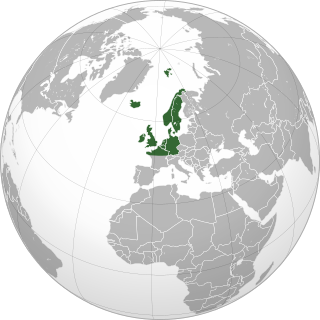Top Qs
Timeline
Chat
Perspective
Northwestern Europe
Geographical region From Wikipedia, the free encyclopedia
Remove ads
Northwestern Europe, or Northwest Europe, is a loosely defined subregion of Europe, overlapping Northern and Western Europe. The term is used in geographic,[1] history,[2] and military contexts.[3]

Geographic definitions
Geographically, Northwestern Europe is given by some sources as a region which includes Great Britain,[4] Ireland,[4] Belgium,[5] the Netherlands,[5] Luxembourg,[6] Northern France,[5] parts of or all of Germany,[7][6] Denmark,[4] Norway,[6] Sweden,[6] and Iceland.[2][8] In some works, Switzerland, Finland, and Austria are also included as part of Northwestern Europe.[6]
Under the Interreg program, funded by the European Regional Development Fund, "North-West Europe" (NWE) is a region of European Territorial Cooperation that includes Belgium, Ireland, Luxembourg, Switzerland, the Netherlands and parts of France and Germany.[7]
Remove ads
Ethnography
During the Reformation, some parts of Northwestern Europe converted to Protestantism,[9] in a manner which differentiated the region from its Roman Catholic neighbors elsewhere in Europe.[10][11]
A definition of Northwestern Europe was used by some late 19th to mid-20th century anthropologists, eugenicists, and Nordicists, who used the term as a shorthand term for the part of Europe with a predominantly Nordic population.[12][13][14][15] For example, Arthur de Gobineau, the 19th-century aristocrat who published works on the pseudoscience of scientific racism, included parts of Northwestern Europe in what Leon Baradat described as his "Aryan heaven".[16]
Remove ads
Genetics
There is close genetic affinity among some Northwest European populations,[17] with some of these populations descending from Bell Beaker populations carrying steppe ancestry.[citation needed] For example, the Beaker people of the lower Rhine overturned 90% of Great Britain's gene pools, replacing the Basque-like neolithic populations present prior.[18]
See also
References
Wikiwand - on
Seamless Wikipedia browsing. On steroids.
Remove ads
